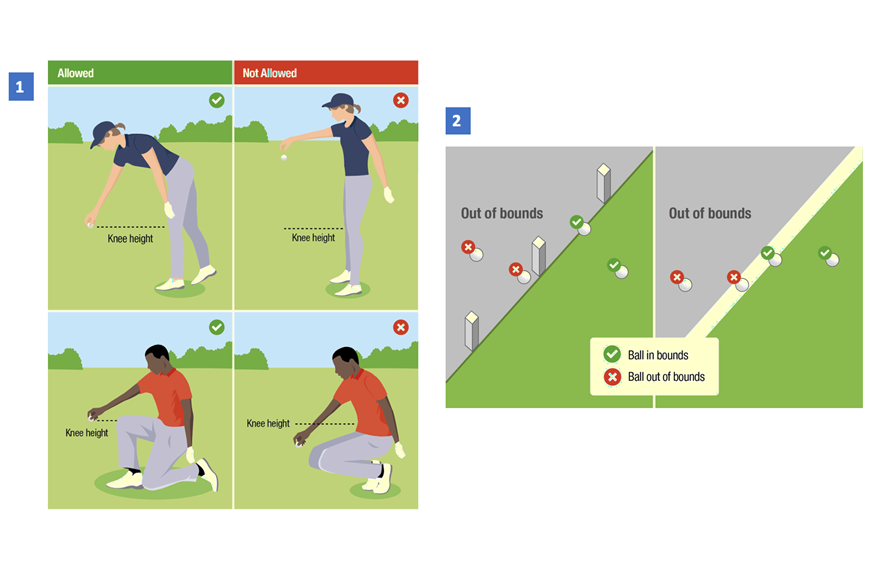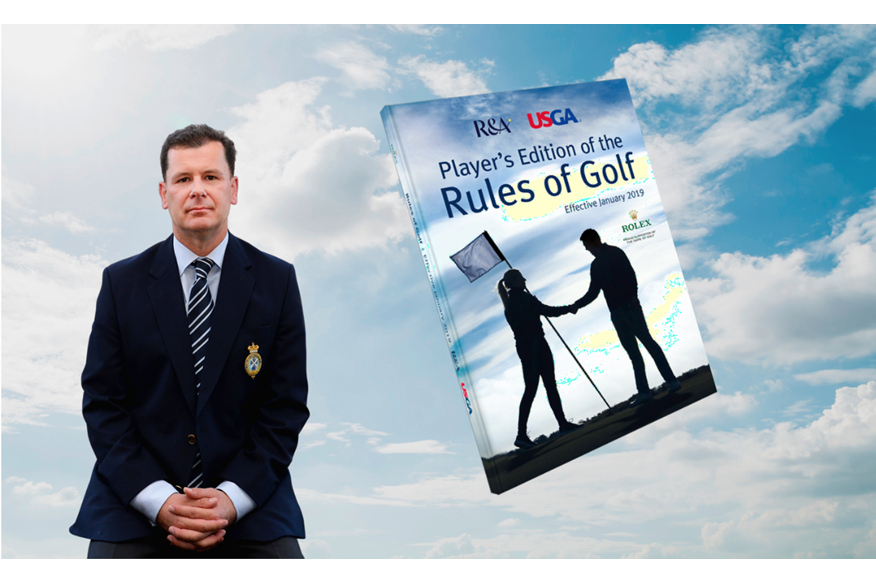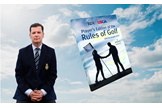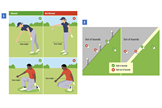Inside the new rules of golf: 11 rules you need to know
Last updated:
Inside the new rules of golf: The R&A’s David Rickman tells us how – and why – they’ve changed
Jump to: 11 new rules you need to know
It’s official! Golf’s new rules have been ratified and published by the R&A and USGA, which means you’ve now got three months to get your head around 24 rules and 300 interpretations. For the first time ever, a print and digital copy of the Player’s Edition has been introduced as a shorter, more user-friendly version of the rules and will serve as the primary publication for all golfers.
Of course, every rules anorak can still get lost in the intricacies of the full Rules of Golf book, which has been updated and sits alongside the Modified Rules of Golf for Players with Disabilities. But why bother when everything is laid out in easy-to-follow diagrams, charts and 10 topical groupings in the Player’s Edition? Whatever your preference, every publication – including a new Official Guide to the Rules of Golf – is now available to access via the R&A website and app, so there’s no excuse for not getting hold of your copy before January 1, 2019.
To help you prepare, we spoke exclusively to David Rickman, Executive Director – Governance at The R&A, to get the lowdown on what golf’s biggest rules change in more than 60 years means for you…
What was the motivation behind such a drastic rules change? Was it simply down to the current list being too complex?
I think that’s a fair summary. When we look back at the history of golf, we haven’t had a review of this kind since 1952. Over the passage of time, we tend to add layer upon layer to the rules and the consequence of revisions is that they become more complicated. At times you need to take a step back and that’s what we’ve done over the last six years. This hasn’t been about turning golf into a different form. We’ve remained faithful to the important fundamentals, but at the same time we recognised that there are technical penalties that we can remove, complex situations that we can simplify and outcomes we can improve.
Therefore, the main work has been to make changes where we can, simplify and modernise where we can, and then focus on how the rules are presented and written. Ultimately, golf is a self-regulating game so we do need millions of our players to understand the rules as best they can. It’s our job to help them.
Why now?
It all dates back to April 2012, so the new rules have been some time in coming. One of the contributory factors was that golf was about to be admitted into the Olympics and that brings a new audience to our sport. There was also a realisation that the rules had become intimidating and needed to be simplified. Every 30 years or so, we’ve undertaken a similar review and we were aware that we had added considerable complexity to the rules, as evidenced by a decisions book which today contains up to 1,200 numbers. As part of this process, we’ve not just reduced the 34 rules to 24, but also changed the 1,200 decisions to 300 interpretations.
How much work has gone into revising the rules?
In my 30 years working at The R&A, this has been the biggest project that we’ve undertaken. It’s been a hugely time consuming and collaborative effort, involving not just ourselves but the USGA, the professional tours and our Rules of Golf committee, which includes advisory members from around the world.
In the world of rules, this is about as exciting as it gets. It’s all about making the rules more intuitive. The answer, more often than not, should coincide with what a golfer thinks. While the rule numbers have changed, a lot of the fundamental philosophies have been left the same, but explained more clearly. We think the rule book is now less intimidating and will help golfers understand why certain rules are in place.
How can golfers brush up on all the changes?
We have released quite a lot of this information already, in particular the full rules being made public in March this year. What we are doing now is releasing the Player’s Edition, which is something new for us. We want to present the rules in a much simpler and easy to understand way. Our website is also live now and the app has also been updated, which we believe is a major tool for all golfers going forward.
It includes not just the Player’s Edition, but also the Official Guide to the Rules of Golf which is aimed at administrators, referees and club committees and lists all the interpretations and procedures. If people want a printed hard copy of the Official Guide, which comes out in November, there will be a cost. But all the material will be available online.
What features in the Player’s Edition?
It’s still a full and proper rulebook. It’s not a guide or a summary. It gives you the detailed answers, but at the same time it deliberately focuses on the most commonly-occurring situations. It’s written in a more direct way, talking to you – the golfer – and it includes illustrations and diagrams which, particularly around relief procedures, make it abundantly clear what options are available.
How do you get hold of it?
Within the UK, we are printing 1.4 million copies of the rules and they are being distributed to all the golf clubs and societies, and will be made free of charge. We will also be translating the book into more than 30 different languages, and these will be available in the coming months.
Just to clarify, are golfers able to check the rules on their phone during competition?
Very much so. On a number of the professional tours, they do have player regulations around the use of electronic devices, but for the rest of us there is no breach.
What has been the reaction to the changes?
In March 2017, we did reveal the main body of work and advised the golfing world to let us know what they thought. We had over 30,000 responses from over 100 countries and that was overwhelming positives. Around that time, I went to a European Tour event and spoke to a dozen or so prominent players. They were all extremely positive about the changes being proposed at that time.
Were there any common queries from club golfers?
Quite a lot of people wanted relief from divot holes on the fairway. I understand that request and as a golfer myself, it is pretty frustrating. But one of the great principles of our sport is “hit it, find it, hit it” so you play the ball as it lies. I think it’s important we still hold strong to the values of our sport. Overall, though, we had no comments or suggestions that we hadn’t covered in our discussions beforehand.
What do you consider the biggest change?
The most visibly obvious changes – and probably the ones people will experience pretty quickly – is the ability to putt with the flag in and repair damage to your line of putt. The dropping procedure is probably just as noteworthy.
In the original proposals, a drop could be taken from any height. What was the reasoning behind changing the wording to knee height?
The dropping rule was probably the first item on the agenda in the first meeting six years. It’s a challenging element and we did talk about moving to “placing” in its entirety. But particularly for relief situations in the rough, we couldn’t get comfortable with a free-relief situation in which a player could get the best possible lie.
Dropping from any height became an issue because we thought some players may try and drop very close to the minimum. In the end, we concluded that the simplest way was to reduce the height of the drop, from shoulder to knee. Our scientists tell us that the ball is now travelling at half the velocity, which means that the ball is less likely to bounce and roll out of the relief area. That’s what we wanted. We want one drop from knee height and for the ball to stay in the relief area to prevent slow play.
How keen are you to stress that the alternative to stroke and distance for a ball that is lost or out of bounds is actually a Local Rule?
That’s an important distinction. Providing options are a good thing, but they can become complicated. There is some misunderstanding that in such circumstances, taking a penalty drop is a rule. It’s not. It’s an optional Local Rule that a club can introduce when conditions warrant it.
Why isn’t it an actual rule?
It all goes back to how golf is meant to be a challenge. A philosophical point to make is that if you fail the test presented in front of you, you should take the test again. Take the Old Course at St Andrews. If the same Local Rule was in place on holes 16, 17 and 18, I would suggest that even with a two-stroke penalty it’s not quite the same challenge. We therefore have to be cautious about introducing a rule which changes the fundamentals of the game.
Do you envisage any teething problems in January?
I hope not. Compared with some of the changes Britain is about to endure, I’m hoping the transition to the 2019 Rules of Golf will be relatively straightforward. From a purist point of view, this is a hard stop on December 31 and come January 1 the new rules will be in play. The good news is that most changes relate to removing penalties or giving players more options. There are relatively few situations in which someone could get it wrong. The dropping rule is perhaps the most obvious, but we are hoping that there will be a concerted push – in the media and at golf clubs – between now and January to help minimise such situations.
Is this it now, or will there be more changes?
It would be unrealistic to think that the rules are now perfect. I think they are very good now, but I’m sure we will have to continue this work and things will evolve. Golfers will continue to hit balls into some very strange places, and maybe that’s part of the attraction of this wonderful sport.
Do you envisage a time when there are separate rules for amateurs and pros?
Golf certainly has a long history of playing by a single set of rules. Golf is one of those few sports where you can make a comparison against the very best. It would be foolish to rule anything out in terms of the future but I think if we were to make changes, we would have to be careful that we don’t reduce the notion that we all play the same game. That remains a very special part of our sport.
If you had one message to club golfers who’ll be playing on January 1, what would it be?
I’d encourage all golfers to get hold of the Player’s Edition, but also to download the app and visit the R&A website, where there are lots of videos and other material. We will have quizzes in the fullness of time and be updating our Rules Academy, so I’d encourage everyone to take the opportunity over the next three months to become more familiar with the 2019 rules.
The new Player’s Edition contains diagrams and illustrations to help you make sense of and implement the rules quickly and easily. These are two simple examples…
1. Knee high drops
No, you can’t squat – and when did your shoulder become knee height?
2. Out of bounds
There’s no excuse for being unable to determine whether a ball is in play or not. Just follow this…

11 NEW RULES YOU NEED TO KNOW
1. The three-minute warning
Your search party has three minutes (down from five) to find a lost ball. However, there’s no penalty for accidentally moving the ball while searching for it.
2. Taking Relief
No announcement is necessary when lifting a ball to identify it or to see if it’s damaged. Players may also select the longest club in the bag – not the putter – when determining where a drop is taken.
3. Plugged lies
Free relief is granted if your ball is embedded anywhere (except bunkers) in the ‘general area’ – the new term for through the green.
4. Double-hits
Accidentally hitting the ball twice will now count as one stroke, rather than two.
5. An alternative to stroke and distance
At club level, a new Local Rule offers the option of taking a drop in the vicinity of where the original ball is lost or out of bounds, including the nearest fairway area, under a two-stroke penalty.
6. Trusting player integrity
A golfer’s “reasonable judgement” when estimating or measuring a spot, point, line, area of distance will be upheld, even if video evidence later shows it to be wrong.
7. Relaxed ‘penalty area’ rules
➤ Red and yellow marked penalty areas (new term for water hazards) may cover areas of desert, jungle, lava rock etc, in addition to areas of water.
➤ Committees are given the discretion to mark all penalty areas as red so lateral relief is always allowed.
➤ No penalty for moving loose impediments or touching the ground or water in a penalty area.
8. Relaxed putting green rules
➤ Players may putt with the flag in or out.
➤ Spike marks and other damage made by shoes or animals may be repaired without penalty.
➤ No penalty for touching the line of a putt or accidentally moving a ball or ball marker.
9. Relaxed bunker rules
➤ No penalty for moving loose impediments or for generally touching the sand with a hand or club (grounding the club right next to the ball will still incur a penalty).
➤ An extra relief option is added for an unplayable lie, allowing the ball to be played from outside the bunker under a two-stroke penalty.
10. Knee-high drops
Forget about dropping from shoulder height. Players must go lower and drop the ball from knee height.
11. Maximum score
A new strokeplay format means your score on a hole can be capped at a maximum by the committee.


